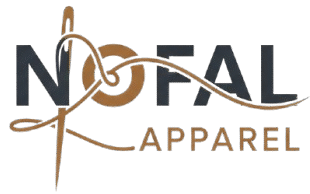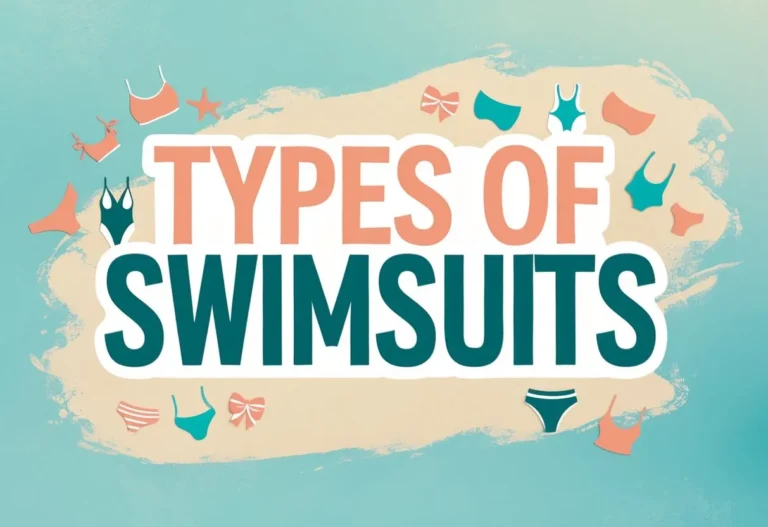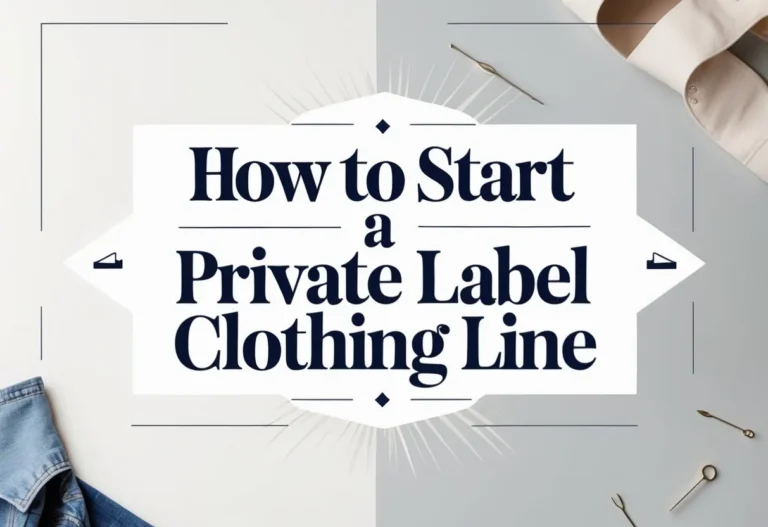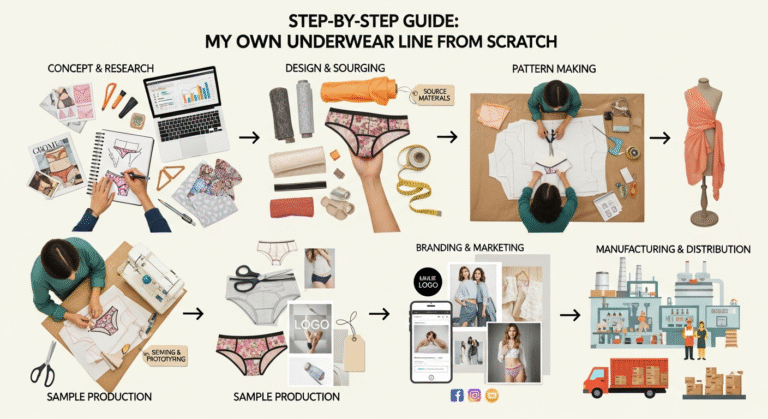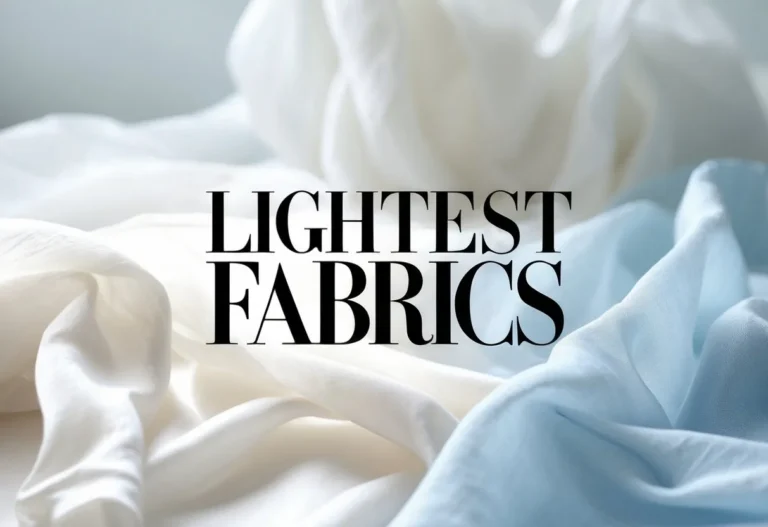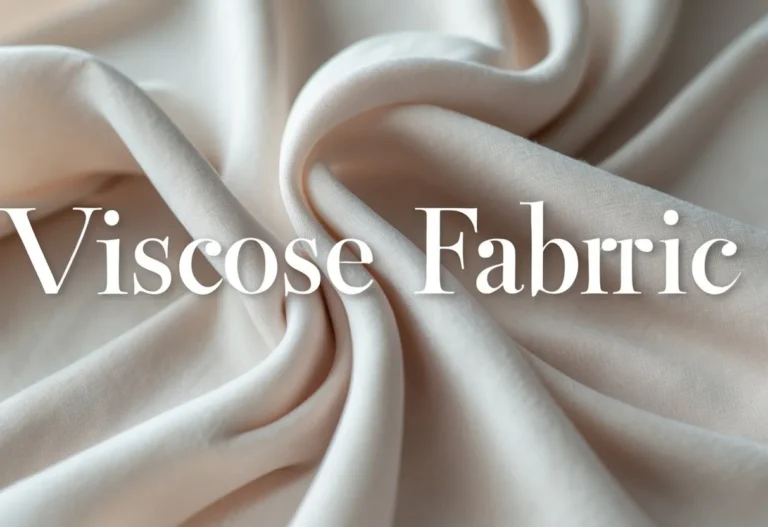Custom hoodies are popular for businesses, teams, and personal use, but many want to know how much it costs to make one. The price to produce a custom hoodie usually ranges from $10 to $50 per unit, depending on materials, design, and order size. This range covers basic options to higher-quality fabrics and more detailed customization.

Several factors affect the final cost. Fabric type is a big part, with cotton-poly blends being cheaper than premium fleece or organic cotton. The printing or embroidery method also changes the price, as more complex designs and special printing cost more to produce. Ordering in larger quantities lowers the price per hoodie because manufacturers use economies of scale.
Other costs to consider include custom labels, packaging, and shipping. These extras add value but increase expenses. Businesses that understand these details can make smarter choices to get the best price without sacrificing quality.
Key Takeaways
- Material quality and design complexity are major drivers of cost.
- Larger orders significantly reduce the price per hoodie.
- Extra features like branding and packaging add to the total expense.
Core Factors Influencing Custom Hoodie Costs
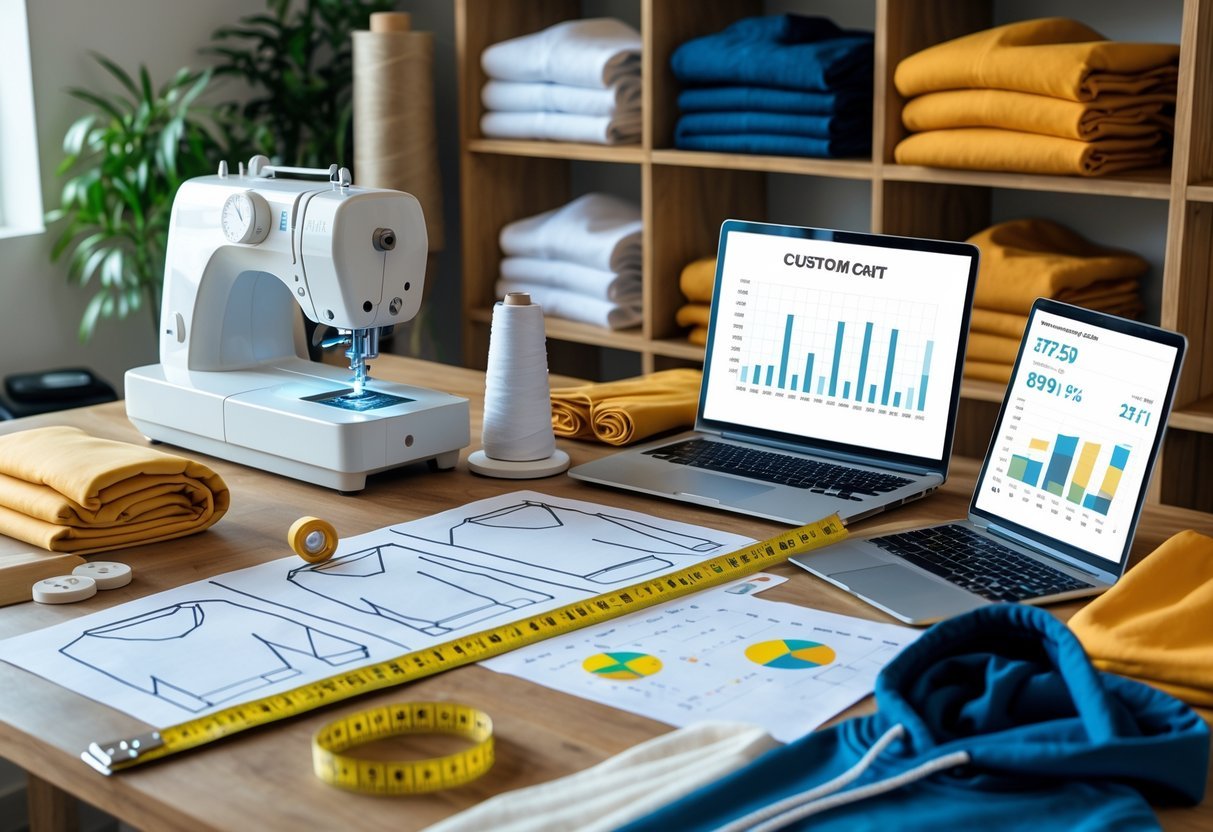
The price to make custom hoodies depends mainly on the base materials, the source of the hoodies, and the design work involved. Each of these impacts the total cost by changing quality, production time, and the level of detail in the final product.
Material Types and Fabric Weight
The choice of fabric greatly affects custom hoodie costs. Hoodies made from 100% cotton tend to be softer and more comfortable but usually cost more. Cotton-polyester blends are common and cheaper, offering durability with less expense. Polyester alone is often the most affordable, especially for activewear-style hoodies.
Fabric weight, often measured in GSM (grams per square meter), influences price and feel. Heavier fabrics (around 300 GSM) are thicker and warmer but cost more than lighter options (200–250 GSM). For custom hoodies, thicker fabric adds to material costs but can increase perceived quality.
Materials labeled as organic or eco-friendly increase the cost by 20–40% due to sourcing and certifications. Knowing fabric type and weight upfront helps in balancing budget and product goals.
Brand and Supply Channel
The brand and where the hoodie comes from also change custom hoodie costs. Well-known brands like Gildan or Bella+Canvas usually cost more but guarantee consistent quality and fit. These brands are often preferred for retail or promotional items where brand trust matters.
Sourcing hoodies directly from factories or wholesalers can lower costs, especially for bulk orders. However, smaller orders usually have higher prices per unit because of minimum order quantity rules.
Supply channels affect not just base costs but also delivery time and reliability. Local suppliers might charge more than overseas factories but save shipping fees and reduce delays. Choosing the right channel depends on budget, quantity, and timeline.
Custom Design Elements
Customization adds variable costs based on design complexity and technique. Simple one- to two-color screen prints are the most affordable method, ideal for large orders with minimal colors. More detailed or full-color designs, usually done by direct-to-garment (DTG) printing, cost more per hoodie.
Embroidery adds texture and a high-quality look, but pricing rises with stitch volume and placement. Each print location (front, back, sleeve) requires extra setup, increasing costs.
Special effects like metallic inks or puff prints further raise prices due to specialized materials and labor.
Setup fees for printing or embroidery are common and can range from $20 to $50 per design, impacting small orders especially. Clear design planning reduces unexpected costs during hoodie production.
Impact of Order Quantities and Production Scale

Order quantity and production scale directly affect the cost and efficiency of making custom hoodies. Larger orders usually lower the price per unit, while smaller orders may cost more due to fixed setup and material expenses. The production steps also change depending on the order size, influencing lead times and costs.
Minimum Order Quantity Explained
Minimum Order Quantity (MOQ) is the smallest amount of hoodies a supplier agrees to make in a single order. MOQs exist to cover fixed costs like machine setup, fabric sourcing, and labor planning. If an order is below this number, the supplier may not find it profitable to produce it.
MOQs vary by manufacturer but often range from 50 to 300 units for custom hoodies. Meeting this quantity helps reduce the cost per hoodie because expenses are spread over more pieces. For small brands or startups, MOQs can present a challenge when budgeting or managing inventory.
Small Orders vs. Bulk Orders
Small orders often carry a higher price per hoodie because many costs stay the same regardless of quantity. Setup fees, minimum fabric requirements, and labor hours mean the total cost doesn’t drop much with fewer units.
Bulk orders benefit from economies of scale. The fabric, labor, and customization costs are divided among many hoodies, reducing the average price per unit. Suppliers may also offer discounts or better terms for large quantities.
| Order Size | Cost per Hoodie | Typical MOQ |
|---|---|---|
| Small orders | Higher | Below MOQ |
| Bulk orders | Lower | At or above MOQ |
Production Process Overview for Cost To Make A Custom Hoodie
The production of custom hoodies generally includes fabric cutting, sewing, adding trims, and customization like printing or embroidery. For large orders, these tasks are streamlined with machinery and batch workflows, which saves time and money.
In small orders, some processes might be done by hand or require extra setup time. This leads to longer production times and higher costs per piece. Quick turnaround requests can also increase prices due to rushed labor and materials.
Understanding this process helps brands make better decisions about order size, timing, and cost management for custom hoodie production.
Customization Methods and Associated Costs
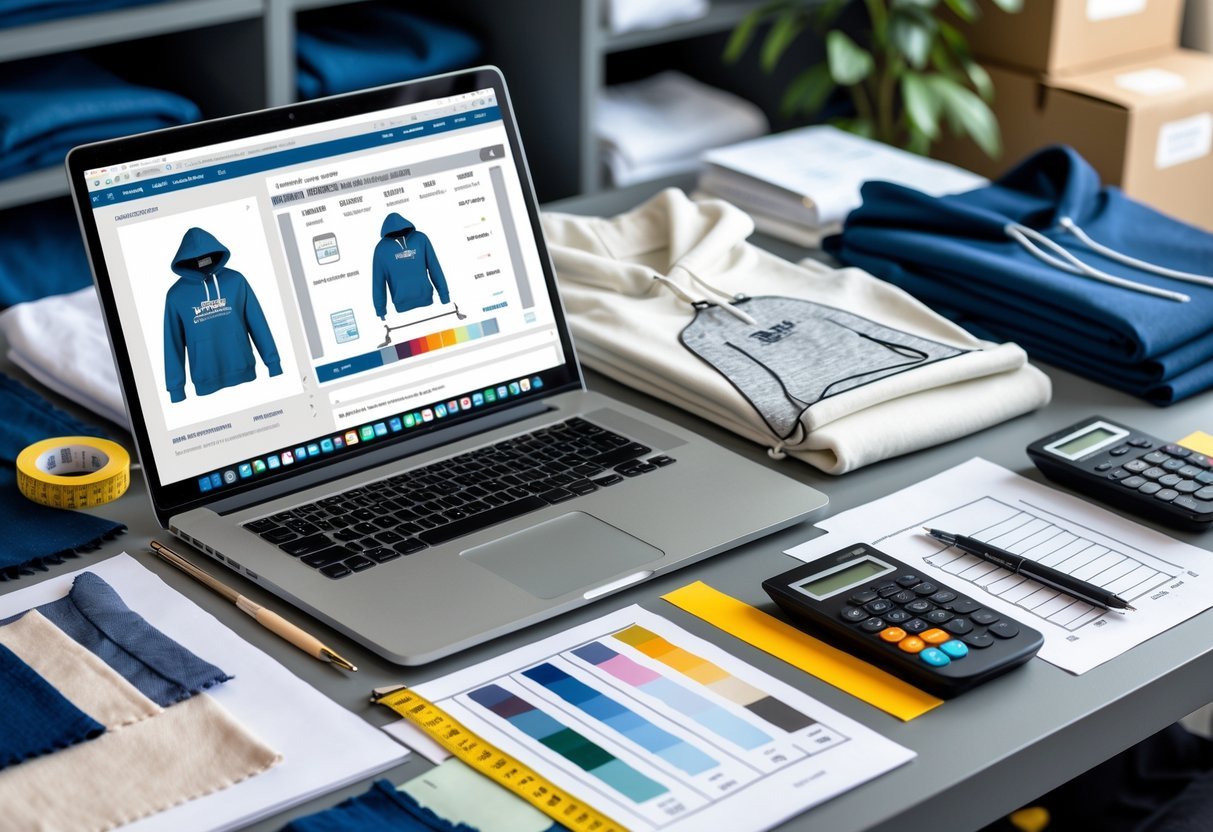
Customizing a hoodie adds to the base price, with screen printing and embroidery being the most common methods. Costs vary depending on design complexity, color use, and production scale. Both methods affect the look, feel, and durability of the final product.
Screen Printing Pricing
Screen printing costs depend on the number of colors and layers in the design. Each color requires a separate screen, so multi-color prints increase setup time and expenses.
For simple, one-color prints, prices might start around $5 to $8 per hoodie. More complex designs with multiple colors can raise the cost to $10 or more per piece. Bulk orders reduce the overall price, as setup fees are spread across many units.
Screen printing is best for bold, flat designs. It works well on lighter fabrics but can feel heavy and less flexible on thicker materials.
Embroidery Cost Breakdown for Cost To Make A Custom Hoodie
Embroidery involves stitching the design directly onto the fabric, which usually costs more than screen printing. Pricing is based on stitch count, design size, and color variety.
Small logos or simple text often start around $8 to $15 per hoodie. Larger, detailed embroidery with many colors can increase the cost to $20 or more per piece.
Embroidery adds texture and durability but can make the fabric stiffer. It suits premium or professional looks and stands up well to frequent washing.
Both screen printing and embroidery costs rise with design complexity and order volume.
Additional Expenses to Consider

Manufacturing a custom hoodie involves more than just material and labor. Other costs, like moving the goods and adding special details, can affect the final price and timeline.
Shipping Fees and Delivery Times for Cost To Make A Custom
Shipping fees depend on the order size, weight, and destination. Larger shipments cost more but often reduce the price per unit. Express shipping options speed up delivery but add significant fees.
Delays may occur due to customs or transport issues. Planning ahead helps avoid rush charges. For international orders, customs duties and taxes might increase costs.
Some factories include shipping in their quote, but many do not. It’s important to confirm these details before placing an order to budget correctly.
Accessory and Label Customizations
Adding accessories like zippers, drawstrings, or metal eyelets increases production cost by $0.30 to $1 per piece. Custom labels or tags add branding value but also cost extra, usually $0.50 to $1.50 each.
Special packaging, such as individual polybags or custom boxes, may add fees and affect how the product arrives to customers.
Simple customization like screen printing costs less than embroidery. Each addition should be weighed against its impact on brand image and customer experience.
Material Choices: Quality and Cost Comparisons

Choosing the right fabric is a major factor in the cost of making a custom hoodie. The type of material affects feel, durability, and price. Quality differences between fibers like cotton, polyester, and blends also shape production expenses. Specialty fabrics raise costs further due to their unique properties.
Cotton vs. Polyester vs. Blends for Cost To Make A Custom Hoodie
Cotton offers a soft, natural feel and is often preferred for comfort. It usually costs more, especially when it is 100% cotton. Polyester is cheaper and more durable, resisting shrinking and wrinkles. However, it can feel less breathable.
Cotton-polyester blends combine the advantages of both. They balance softness, strength, and cost. A common blend (usually around 60% cotton, 40% polyester) provides comfort with improved durability and often costs less than pure cotton hoodies.
Typical fabric cost ranges:
- Cotton: $7–$12 per yard
- Polyester: $2–$6 per yard
- Cotton-polyester blend: $3–$7 per yard
Blends are popular for custom hoodies as they can keep production costs moderate while maintaining good quality.
Specialty Fabrics and Upcharges for Cost To Make A Custom Hoodie
Specialty fabrics include organic cotton, heavy fleece, and performance materials. Organic cotton is grown without chemicals and costs significantly more, often upcharging by $3–$6 per yard compared to regular cotton. Heavy fleece uses a thicker fabric weight (350–400 GSM) and is warmer but adds $4–$6 to material expenses.
Performance fabrics that wick moisture or add stretch also increase costs due to their advanced properties and more complex manufacturing.
These materials raise the total cost of producing a hoodie, sometimes by $5 to $15 or more per unit. Choosing specialty fabrics suits brands targeting high-end or niche markets willing to pay more for quality features.
Tips for Saving on Custom Hoodie Production

Saving on custom hoodie costs requires smart choices in design and manufacturing. Careful planning of order size and design details can reduce expenses without hurting quality. Choosing the right manufacturer also plays a big role in managing overall costs.
Optimizing Design and Order Size
The design directly affects custom hoodie cost. Using fewer colors in prints lowers ink use and setup fees. For example, a 1-2 color screen print is cheaper than a full-color DTG print. Limiting print areas to just the front chest or small logos also cuts costs.
Order size impacts the unit price. Larger orders often get discounted rates from manufacturers. Combining orders with other groups to meet minimum order quantities (MOQ) can save money. Ordering off-peak, outside the busy Q4 season, may also reduce custom hoodie costs by 5-15%.
Selecting the Right Manufacturer
Choosing a local or regional manufacturer helps save on shipping and customs fees. Despite slightly higher base prices, local suppliers often offer faster turnaround and better communication. This reduces risks of delays and quality issues.
Bulk orders should be planned with manufacturers who provide clear pricing on extra fees like setup, samples, and packaging. Negotiating long-term contracts may lock in better rates and priority service. Using manufacturers with stocked fabrics and blanks avoids added costs from custom dyeing or small-batch production.
Frequently Asked Questions
Cost To Make A Custom Hoodie involves several cost factors, including materials, design, and order size. Prices vary depending on how complex the design is and whether the order is large or small.
What factors influence the cost of producing a custom hoodie?
Material type, fabric weight, and brand affect the base cost. Customization methods like screen printing, embroidery, or special effects add to the price. Order quantity and additional services such as design fees or packaging also impact the total cost.
How much does it usually cost to order a single custom hoodie?
A single custom hoodie often costs more than bulk orders. Prices typically range from $15 to $25 for basic designs and can go higher depending on fabric quality and customization.
Are there additional charges for including a picture or intricate design on a custom hoodie?
Yes. Complex or multi-color designs usually increase printing costs. Detailed images often require more setup time or expensive printing methods like direct-to-garment, raising the price per piece.
Can you suggest ways to minimize the cost of custom hoodie production without compromising quality?
Choosing local suppliers reduces shipping costs. Simplifying designs, using in-stock fabrics, and placing orders during off-peak seasons also save money. Group ordering with others can help meet minimum order quantities and lower unit prices.
What is the price difference between bulk orders and individual custom hoodie orders?
Bulk orders significantly lower the cost per hoodie, often below $10 for basic options. Individual orders are pricelier due to smaller quantities and setup fees, sometimes costing two to three times more per hoodie.
How do design complexities affect the overall pricing of custom hoodies?
More colors, larger print areas, and special effects increase the cost. Each additional print location, like sleeves or hood, adds extra charges. Setup fees for complex designs can raise the initial cost before production begins.
